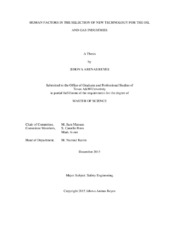| dc.description.abstract | The evolution of organizations comes with changes in two core elements: human factors and technology factors. The introduction of new technology is one of the most important processes considered to improve the performance of any system, and it contemplates the combination of human and technology elements.
When one talks about the selection of new technology to improve systems, the most important problem is that there is no model or guide to show how to start. A model is needed to explain which elements require more attention and where investment of economic and human resources is needed in order to develop a highly reliable design. In addition, the model may reduce human error, incidents, injuries, and improve productivity.
One of the problems is that there is limited access to reliable sources of information related to human and technology factors in the oil and gas industries. Even when information is available, applications are limited and the relationships between factors are unclear.
If those relationships are established there can be a clear indication of the areas that need to improve. Therefore, in many cases organizations do not implement the best technology in their systems or processes, which will limit their results and potentially introduce new problems. Likewise, many companies use “common sense” and select the state-of-the-art or most expensive technology, but do not consider the most optimal equipment to achieve their goals.
As a solution to this problem a Bayesian Network based New Technology Change (NTC) model has been developed, which semi quantitatively assesses the effect of the combination of Human and Technology Factors on the risk of process safety incidents. This model analyzes the risk by incorporating technology factors into an event tree model. The technology factors were quantified by a survey and the human factors by using statistical data from the International Association of Oil and Gas Producers. We found that the model is useful to identify a clear relationship between human factors and technology factors to quantify the change in frequency of process safety incidents, to evaluate the impact of preventive barriers and actions, and to determine which elements are better investments in order to improve the safety performance of an organization.
In summary, it has developed a methodology for the identification, evaluation, and selection of new technology by focusing on the relationship of the principal technology characteristics and human factors. When this relationship is established, the early process of selection of new technology will be impacted. Thus, it will be easier to identify the factors that can be considered in the selection of new technology, and determine how to evaluate the success or failure of its implementation. | en |


